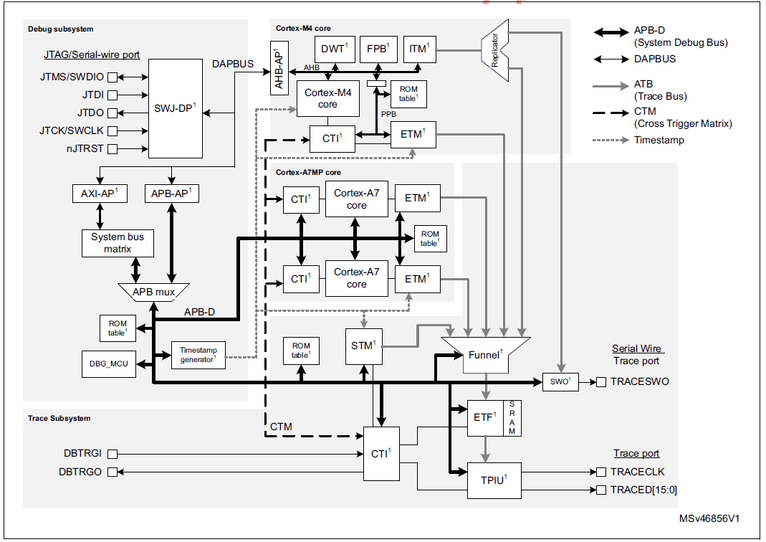This article gives information about the ARM® Coresight subsystem.
It explains what are the principle peripherals of this subsystem, how they interact, and how to activate them.
1. Framework purpose[edit source]
ARM® Coresight products include a wide range of trace macrocells for ARM® processors, system and software instrumentation and a comprehensive set of IP blocks to enable the debug & trace of the most complex, multi-core SoCs.
ARM® has defined an open CoreSight architecture to allow SoC designers to add debug & trace capabilities for other IP cores in to the CoreSight infrastructure.
Coresight can be used in many different use cases, as mentioned in How to use Coresight section.
2. System overview[edit source]
2.1. Components description[edit source]
The debug features are based on Arm® CoreSight™ components:
• SWJ-DP: JTAG/Serial-wire debug port
• AXI-AP: AXI access port
• AHB-AP: AHB access port
• APB-AP: APB access port
• ITM: Instrumentation Trace Macrocell
• DWT: Data Watchpoint and Trace
• ETM: Embedded Trace Macrocell
• ETF: Embedded Trace FIFO
• TPIU: Trace Port Interface Unit
• SWO: Serial Wire Output
• CTI: Cross Trigger Interface
• CTM: Cross Trigger Matrix
• Timestamp Generator
• STM: System Trace Macrocell
More information about these components can be found in the Arm® documents referenced [1]
2.2. Features[edit source]
Refer to STM32MP15 reference manuals for the complete list of features, and to the software components, introduced below, to see which features are implemented.
3. Principle[edit source]
Internal peripheral generates a trace stream, namely instruction traces, depending on instructions and events happening when CPUs are executing a program. This encoded stream can be then stored in a dedicated SRAM via a buffer or extracted through an external JTAG port.
4. Configuration[edit source]
4.1. Kernel configuration[edit source]
Detailed procedure on how to activate the Coresight subsystem :
4.2. Device tree configuration[edit source]
Detailed DT configuration for STM32 internal peripherals:
5. How to use the subsystem[edit source]
See examples in How to use Coresight.
6. References[edit source]
- ↑ [1. IHI 0031C (ID080813) - Arm® Debug Interface Architecture Specification ADIv5.0 to
ADIv5.2, Issue C, 8th Aug 2013.
2. DDI 0480F (ID100313) - Arm® CoreSight™ SoC-400 r3p1 Technical Reference Manual, Issue F, 26th Sept 2013.
3. DDI 0461B (ID010111) - Arm® CoreSight™ Trace Memory Controller r0p1 Technical Reference Manual, Issue B, 10 Dec 2010
4. DDI 0314H - Arm® CoreSight™ Components Technical Reference Manual, Issue H, 10 July, 2009
5. DDI 0403D (ID100710) - Arm® v7-M Architecture Reference Manual, Issue Derrata2010_Q3, November 2010
6. DDI 0468A (ID101712) - Arm® CoreSight™ ETM™-A7 r0p0, Issue A, 12 Sept 2011
7. DDI 0440C (ID070610) - Arm® CoreSight™ ETM™-M4 r0p1 Technical Reference Manual, Issue C, 29 June 2012
8. DDI 0528B (ID062514) - Arm® CoreSight™ STM-500 System Trace Macrocell r0p1 Technical Reference Manual, Issue B, 11 March 2014
9. DDI 0464F (ID051113) - Arm® Cortex®-A7 MPCore™ r0p5 Technical Reference Manual, Issue F, 11 April 2013],Arm® documents referenced
